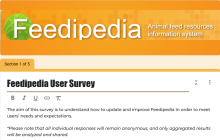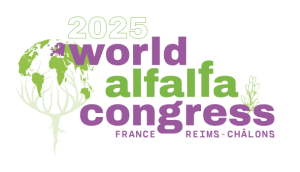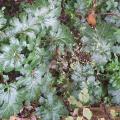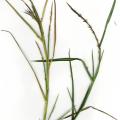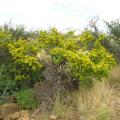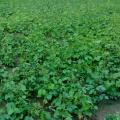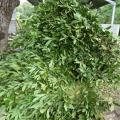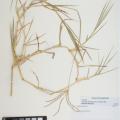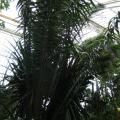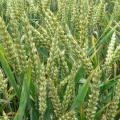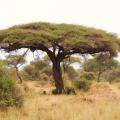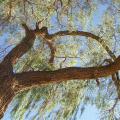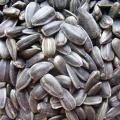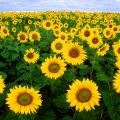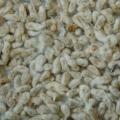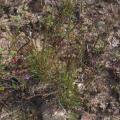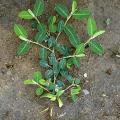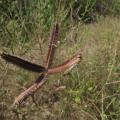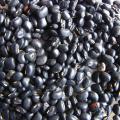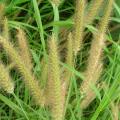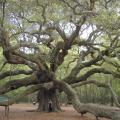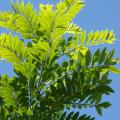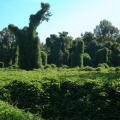Feedipedia news
After 13 years, it is time for the website to be upgraded! Before we start, we need your input.
Explore Feedipedia
|
Acanthus mollis L. is a perennial herb that can grow to a height of 0.9-1 m. It... Read more |
Limpo grass (Hemarthria altissima (Poir.) Stapf & CE Hubbard) is a grass... Read more |
False brandy bush (Grewia bicolor A. Juss.) is a many-stemmed shrub that may... Read more |
|
The mung bean (Vigna radiata (L.) R. Wilczek) is a legume cultivated for its ... Read more |
The Indian laurel (Litsea glutinosa (Lour.) C. B. Rob.) is an evergreen, or... Read more |
Giant star grass (Cynodon plectostachyus (K. Schum.) Pilger) is a robust,... Read more |
|
Oil palm fronds are a by-product of the cultivation of oil palm trees (Elaeis... Read more |
Wheat (Triticum spp.) is one of the most important staple food crops for humans... Read more |
Acacia tortilis (Forssk.) Hayne is a thorny legume tree, usually about 4-8 m... Read more |
|
The tamarugo (Prosopis tamarugo F. Phil.) is a deciduous legume tree growing up... Read more |
Sunflower seeds are the fruits (achenes) of the sunflower (Helianthus annuus L... Read more |
Sunflower (Helianthus annuus L.) is the 5th most important oilseed... Read more |
|
Cotton seeds are the seeds of the cotton plant. Cotton seeds are... Read more |
Common needle grass (Aristida adscensionis L.) is an annual or short-lived... Read more |
Red moneywort (Alysicarpus rugosus (Willd.) DC.) is an upright robust annual... Read more |
|
Egyptian crowfoot grass (Dactyloctenium aegyptium (L.) Willd.) is a tufted,... Read more |
Cowpea (Vigna unguiculata (L.) Walp.) is one of the most popular grain legumes... Read more |
Mission grass (Pennisetum polystachion) is an annual or perennial grass, with... Read more |
|
The live oak (Quercus virginiana) is a shrubby to large perennial tree up to 20... Read more |
Gliricidia sepium (Jacq.) Kunth ex Walp. is a perennial, medium-sized (2-15 m... Read more |
Kudzu (Pueraria montana (Lour.) Merr.) is a perennial climbing, trailing vine... Read more |
Pages
Recent resources
 Opinion paper: Phasing out of the aid provided to the livestock sector during expectedly recurrent emergencies
- Makkar, 2024. animal
Opinion paper: Phasing out of the aid provided to the livestock sector during expectedly recurrent emergencies
- Makkar, 2024. animal
Open access opinion paper that makes a case that the emergency aid do more harm than good to African countries. It is valid for all the fields of agriculture but has direct consequence for animal agriculture. The context here is the aid provided during emergencies that are foreseeable recurrent.
The role of livestock in food security, poverty reduction and wealth creation in West Africa
- Molina-Flores et al., 2020. Food and Agriculture Organization of the United Nations Accra, 2020
Livestock is key to 377 million people in West Africa and in some countries, up to 60% of the population is involved in livestock production. The demand for animal products is increasing with population growth, urbanization, growing middle class, and due to shifting consumer preferences towards animal products. To meet this growing demand, countries in West Africa must engage in accelerated sustainable livestock production undertaking. Livestock development is key to eradicate hunger and poverty. This book attempts to provide up-to-date, and reliable information on the potentials, opportunities, and challenges of the livestock subsector in West Africa.
Pulses and their by-products as animal feed
- Sherasia et al., 2017. In: Calles, T.; Makkar, H. P. S. (Eds), FAO, Food and Agriculture Organization of the United Nations, Rome, Italy
This document provides a state-of-the-art review of the recent research (published and unpublished) on the use of pulses and their by-products as animal feed. It aims at raising awareness on the use of pulses and their by-products. It highlights the nutritional role of pulses and pulse by-products as animal feed and is a contribution to the legacy of the 2016 International Year of Pulses. This document will further enhance the use of these feed resources in other continents, besides Asia, where many pulse by-products are simply dumped. It is also expected that the synthesis presented contributes to make the use of pulses and their by-products as animal feed more efficient. This document will be useful for extension workers, researchers, feed industry, policy-makers and donors alike.









